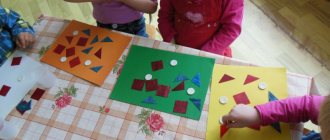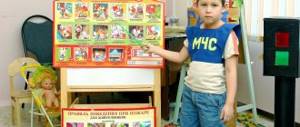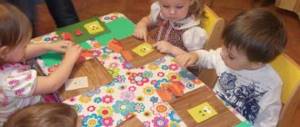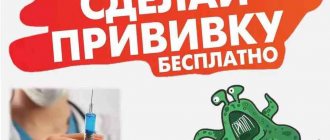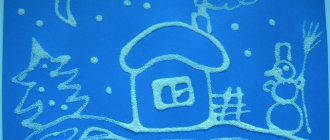Abstract of GCD in junior group 1 on the topic: Walk through the autumn forest
Lesson in the first junior group “Walk through the autumn forest.
Visit the Hedgehog" GOAL: 1. To introduce children to the features of living nature. 2. Learn to understand the behavior and habits of animals. 3. Cultivate an interest in nature, a kind attitude towards all living things. 4. Expand your understanding of the lifestyle of wild animals in the fall (how they prepare for winter). 5. Strengthen the ability to compose various phrases and short simple sentences. VOCABULARY: 1. Fly agaric;
2. White mushroom; 3. Leaf fall; 4. Edible, inedible; 5. Yellow, green, red; 6. Cloudy, cold, golden autumn. PROGRESS OF THE CLASS
The group is decorated with autumn leaves (yellow, red, green).
The teacher asks a riddle. Educator: Guys, I’m now going to tell you a riddle, and you listen carefully. If the leaves on the trees have turned yellow, If birds have flown to a distant land, If the sky is gloomy, if it is raining. This time of year, what is it called? (Autumn) Children: Autumn. Educator: Do you want to go visit the mistress of autumn? How to find the way? Look, maybe autumn has left us its clues? Leaves were laid out and hung along the way. There are environmental posters hanging on the walls (bugs, nest, lily of the valley, anthill, stream). Children enter the group.
Educator: Guys, what time of year is it now? Children: Autumn. Educator: What is autumn like? Children: Golden, rainy, cloudy. Educator: Guys, come to me, look at what beautiful pictures are drawn. The forest is washed with warm rain, Leaves and grass whisper, And the trunks raise the crown of the green oak grove to the sky. Having chosen an observation post in the branches, Rejoicing in the shower in July, As if on a swing, a thrush swings With a drop of sun on its beak. (S. Makhotin) A stomp is heard. Educator: Guys, hear stomping. Who goes? Guess the riddle. There are needles on the back, long and prickly. And he curls up into a ball - There is no head, no legs. Children: Hedgehog. Educator: Hedgehog, what's your hurry? Hedgehog: It's cold. Frozen. Educator: Hedgehog, do you want to play with us? You'll warm up. Guys, let's warm up the hedgehog. Guys, you will all be mice, and I will be a hedgehog. P/I Game “Hedgehog” A hedgehog walked along the path (children walk one after another) And found a fungus in the grass (children bend forward and squat, “take” an imaginary mushroom with their hands) He attached it to needles (children stand up and “put” the mushroom) And headed home. (children walk after each other) A hedgehog ran along the path (children run after each other) Found an apple in the grass (children bend forward, squat and “take” an imaginary apple with their hands) Put it on needles (children stand up and “put” the apple on their heads - “needles”) And he hurried home again. (children run after each other) The hedgehog came to his home, (children start walking and stop) He opened the door in the pantry. (they open the doors with both hands) Folded the mushroom and apple - (they remove the mushroom and apple from the head and put them, squatting, halfway - 2 times) He lived through the winter without any hassle. (stand up and show the “class” sign with both hands) Teacher: [/b Hedgehog, are you warm? Hedgehog: Thanks, guys! Got warm. Guys, yours is so beautiful. Such beautiful leaves. Can you help me and collect a bouquet. Educator: Guys, let's help the hedgehog. Educator: The autumn wind blew. Leaves flew from the trees. The leaves have begun to fall. What is it called when the leaves fly? Children: Leaf fall. Outdoor game "Falling Leaves". Educator: Guys, now let's collect the leaves in a basket and give them to the Hedgehog, let him decorate his house. A bouquet of leaves is handed over to a hedgehog. Hedgehog: Thanks, guys! Now I won't freeze. Educator: And we know a song about you, Hedgehog. Song "Hedgehog". Educator: Hedgehog, do you really like mushrooms? Hedgehog: Very much. But I don't know what mushrooms to pick. Educator: And we, Hedgehog, will help you. The teacher shows two pictures with mushrooms: fly agaric - inedible, white - edible. Educator: What is shown in the picture? Children: Mushrooms. Educator: What are the mushrooms called? Which of these mushrooms is edible? Will we collect fly agaric? Children: No. Educator: Why? Children: Not edible. Children collect edible mushrooms in a basket and give them to the hedgehog. Hedgehog: Thank you guys very much! They helped me put together a beautiful bouquet and prepare food for the winter. For this I will treat you to apples. The hedgehog treats the children with apples, says goodbye and goes into the forest.
We recommend watching:
Summary of a lesson on speech development for the 2nd junior group. Pleshcheev “Autumn” Summary of OOD in the junior group with presentation. A Journey to the Autumn Forest Notes on social and communicative development in the 2nd junior group on the topic: Autumn Notes on social and communicative development in the 2nd junior group on the topic “Autumn has come to us”
Similar articles:
Lesson notes for the younger group. Broken applique “Autumn leaves”
Walk "Spring" in the younger group
SUMMARY OF THE WALK (SPRING)
in the younger group
Tasks
:
-Create conditions for the development of observation by identifying new signs of spring.
-Create conditions for the development of cognitive interest, need and ability for independent search activity.
-Create conditions for the development of attentiveness, imagination, speaking,
-Create conditions for maintaining a joyful, gracious, good mood.
Integration of educational areas:
Cognitive development: Introduce children to such a natural phenomenon as wind, the reasons for its occurrence, and its role in life. Develop the ability to draw conclusions. Strengthen the ability to establish cause-and-effect relationships and develop the ability to resolve controversial issues.
Speech development: Develop children’s speech, the ability to answer questions in full sentences.
Social and communicative development: Develop a caring attitude towards the results of the work of adults, encourage children to maintain order, cleanliness, and provide assistance to adults.
Artistic and aesthetic development: Develop ideas about spring by solving riddles, becoming familiar with folk signs.
Physical development: Develop physical qualities. Strengthen the skills acquired in physical education classes. Cultivate interest in outdoor games and a healthy lifestyle.
Remote material:
A letter from a “cloud” for experimental activities, boats made of paper, a basin of water, attributes for outdoor games: cloud masks, a ball.
Walking progress:
— Guys, guess the riddles:
Fluffy horse,
Or maybe a hippopotamus
Or maybe just cotton wool
Floats above us into the distance. (cloud)
- That's right, these are clouds. Guys, admire the clouds, they are clearly visible in the spring, bright white, large, with clear outlines. Now look carefully at the clouds and compare them with famous animals or objects, what do they look like? (children's answers)
-Listen to another riddle:
It flies without wings and runs without legs.
(wind)
- You guessed correctly - it's the wind. How do clouds move? (sometimes slowly, sometimes quickly) What drives them? (wind.) If the wind is stronger, the clouds move faster and often change shape
Admire the clouds through a lacy network of verdant tree branches. A letter in the form of a “cloud” hangs on one of the branches.
Guys, what is this? (children's answers). Let's read it.
I open the letter and take out the boat.
- Children, what is this? What did the cloud mean? The children reason that in spring there are many streams and boats can be launched along them.
— Guys, listen to the poem:
The wind blows across the sea and propels the boat. It runs in the waves, on swollen sails, the wind makes a cheerful noise, the ship runs happily (A.S. Pushkin)
- Guys, the cloud gave us a riddle. What needs to be done with the boat?
Children offer to lower the boat into the water.
Experimental activities:
— We lower the boats into a pan of water. The children blow on the sails (quietly at first, then stronger and stronger), the boats sail.
- Guys, large sailing ships move thanks to the wind.
What happens to the ship if there is no wind? What if the wind is very strong?
Children reason that the nature of the wind may be different; they conclude that the speed of the boat depends on the speed of the wind.
- Guys, what can the wind do? (Children's answers: it can make noise, hum, shake trees, rustle leaves, howl, swoop, refresh, swirl, develop flags, raise dust, swirl leaves).
- Yes, guys, the wind can do a lot. Can it harm a person?
(Children's answers: breaks trees in the garden, rips a hat off his head, throws dust and sand in his eyes and overturns cars).
- How does the wind help us? (Children's answers: inflates the sails, turns the wings of the mill).
“That’s how different the wind is, but now think about what the wind can be like?” (Children's answers: strong, weak, pleasant, affectionate, quiet, cool, warm, refreshing, gentle, pleasant, fast, unnoticed).
- Guys, look, there’s something else in the letter, let me read it to you.
Long icicles for a long spring.
When lightning flashes in early spring, but thunder is not heard, it will be a dry summer.
When there are a lot of cobwebs flying in the spring, the summer will be hot.
If a lot of sap flows from a birch tree, then summer will be rainy
When birds build their nests on the sunny side, this means cold summer.
- What did the cloud want to tell us about? (Children's answers: these are folk signs of spring, from them you can determine what kind of summer awaits us).
Outdoor game. “Wind and clouds” Progress of the game: To the sound of a tambourine, children pretend to be the wind (run scattered around the area). After the signal “The clouds have gathered,” the children should stand in pairs. The game becomes more difficult; children gather in threes, fours, a cloud of only girls, or only boys.
Didactic game “On the contrary”
Progress of the game: I name the word, and the children name the opposite meaning. Big - small, distant - close, cloudy - transparent, weak - strong, quiet - loud, light - heavy.
Conversation: The work of an adult on the site.
I suggest children pay attention to the cleanliness of the area.
—Who do you think worked here? (Children's answers). What kind of profession is a janitor? What does he do? Yes, guys, a janitor is a profession related to maintaining cleanliness and order in the yard and on the street.
-Children, what needs to be done to keep the area clean? (Children's answers: pick up trash, don't litter). Yes, there is even a saying: “Clean is not where they clean, but where they don’t litter.” Therefore, no matter where you are: walking on the property, on the playground, in the forest, always maintain cleanliness and order.
Individual work.
Game “Throw it to the skies” with Sasha, Egor, Kapa. Goal: To create conditions for improving the ability to throw and catch a ball. Promote the development of motor skills. Develop dexterity and attention.
Free activities for children as desired.
The teacher and the children of the second subgroup remove toys from the area and enter the group.

